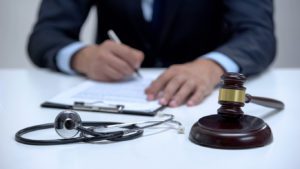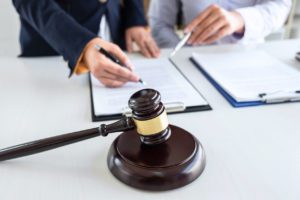










We have all heard the saying “everything happens for a reason,” and usually, accidents happen because someone was not careful enough.
Negligence happens when one person’s carelessness causes injury or harm to another person.
When an injury victim makes a personal injury claim, they will have to establish four (4) essential “elements” to prove negligence:
To illustrate how these elements work, let’s say you were injured in a rear-end collision. It happened at a red light, and the driver behind you was distracted due to texting while driving.
As obvious as it may seem, your ability to recover damages depends on proving the elements to show that the other driver was negligent.
After an accident occurs, it may be immediately clear who is at-fault for the accident. In other cases, it can be a lot more murky when trying to decipher who the negligent party was. Whether it is obvious or not that negligence was the cause of an accident, it can be difficult to prove that negligence is what led to your injuries.
If you have been involved in an accident in Boston, it is crucial that you speak with a personal injury lawyer. Our trusted personal injury lawyers will help you decipher whether negligence is what caused your accident by ensuring you understand what the elements of negligence are. The elements of negligence are:
When an accident occurs, before it can be proven that another party was negligent and caused the accident, you must provide proof that there was a duty of care. A duty of care is established between the two parties involved in the accident where one party had a legal obligation to exercise reasonable care in order to prevent them from becoming injured or harmed.
For example, a doctor owes their patients a duty of care when they undergo medical procedures.
Drivers on the road also owe each other a duty of care to be reasonably safe and not act recklessly or carelessly.
During a personal injury case, the court must determine if the party that had a duty of care to the other was in breach of that duty. Evidence of a breach of the duty of care may include:
The defendant will likely be found negligent if there is evidence that the duty of care was breached.
Also referred to as causation, this element requires that the victim must provide evidence that the defendant’s breach of the duty of care is what led to their injuries.
In this final element of negligence, the victim must show proof that the injuries they have suffered have resulted in losses like medical expenses or property damage.
If you are unsure if your case follows all the elements of negligence, our team of Boston personal injury lawyers may be able to help. When you choose to work with Sweeney Merrigan Law you will have access to a team of award-winning personal injury lawyers.

First, an injury victim must show a “duty” existed. Specifically, the injury victim (plaintiff) has to show that the person responsible for the injury (defendant) owed them a duty of care.
A duty of care is a standard of behavior. It is established by law or custom. A duty of care requires a person to act in a certain way to protect others from an increased risk of harm.
What is the standard of behavior? It depends on the circumstances.
Overall, a person generally has to behave in the same way that a reasonable person would behave under the same circumstances.
In the situation of the driver who caused the rear-end accident, the duty of care is fairly straightforward. Since both drivers were on the same road simultaneously, the driver owed the same duty of care that all drivers owe to others. This means the other driver has to act the same way that a reasonably careful person would act in the same situation.
Once a duty of care is proven, the plaintiff (injury victim) must establish the defendant breached their duty of care. A breach is a violation of a law or contract.
In negligence cases, a breach means that the defendant’s behavior, whether through their act or failure to act, violated the duty of care they owed you. In other words, they acted in a way that was unreasonable under the circumstances.
When a person’s acts are illegal, such as running a red light, it can be easier to establish that they breached the duty of care.
For the person who rear-ended you in a car accident, you would need to prove that they were distracted by something or driving recklessly. If your attorney could use cell phone records to establish that they were, in fact, texting and driving, you may have a better chance of recovery.
Put simply, you have to show that the driver’s actions were inconsistent with the actions a reasonable driver would have taken under the circumstances.
The third and probably the most important element of negligence is causation. The injured plaintiff has to prove that the defendant’s careless acts (or omissions) caused the plaintiff’s injuries.
Particularly, a plaintiff has to prove that the defendant’s acts were the direct and proximate cause of the plaintiff’s injuries. Here’s what that means:
Direct cause, also known as “cause in fact,” means that you would not have been hurt if the defendant had not breached the duty of care. Direct cause requires proving you would not have been harmed “but for” the defendant’s careless act (or failure to act).
Proximate cause is also called legal cause. This means that your injuries were a natural and foreseeable result of the defendant’s act (or failure to act).
In some cases, direct cause is established, but proximate cause is not present.
In the example of the rear-end collision, you would need to show that the accident would not have happened but for the defendant’s careless act of texting and driving.
You must show that your potential injuries, such as evaluation in the emergency department, lost wages from missing work, car damage, and emotional distress, are all foreseeable consequences of being in a car accident.

Lastly, a plaintiff must prove they experienced damages as a result of their injury. An injured party is entitled to damages from an at-fault party to compensate for their losses.
Some people believe that injury must be a physical injury. While many negligence cases do involve bodily injury, a physical injury is not always required to recover compensation.
Damages can include negative impacts generally, whether physical, emotional, or financial.
It is important to note that the plaintiff will be required to show some bodily damage or property damage in most situations. Claims for purely non-economic damages, like emotional distress, are handled under different rules.
In order to succeed on a claim of negligence, you have to be able to show an injury or damages of some kind. Without damages, negligence does not give rise to a cause of action. This means you cannot be entitled to be compensated if there is no injury, damage, or loss.
In the rear-end collision case, let’s say you spent the day of the accident in the local emergency department and missed half a day of work. You were in a leased car at the time of the accident, and the bumper was badly damaged.
Also, you realize that you are suffering from negative psychological effects as a result of the accident. As a result, you are unable to drive to work, church, or visit your family members.
Our team’s personal injury attorneys may be able to help you gather the financial documents and medical records you need to establish the value of your financial losses as well as your non-economic losses. If you were injured due to someone else’s negligence, you should contact an experienced Boston personal injury lawyer to help you with your claim.
If you have been involved in an accident caused by a negligent party in Boston, Massachusetts, our personal injury firm is ready to help you build a strong claim. Call our office at (617) 391-9001 or reach out online to schedule a free consultation with an experienced Boston personal injury lawyer.
Our trusted legal team is led by our experienced co-managing partners, J. Tucker Merrigan and Peter M. Merrigan. J. Tucker Merrigan has been a co-managing partner of the firm for over a decade. He has been recognized for his work in the Massachusetts legal system with awards that include: Under 40, National Trial Lawyers; 2020-2021 Lawyer.com Top Attorney Award. Our other co-managing partner, Peter M. Merrigan, has been recognized for his work helping the communities of Boston: 2018 Top 40 Under 40, National Trial Lawyers; 2021 Massachusetts “Super Lawyer.”
We use cookies on our site to analyze traffic, enchance your experience, and provide you with tailored content.
For full functionality of this site, you must consent to the use of cookies. For more information or to opt out, visit our privacy policy